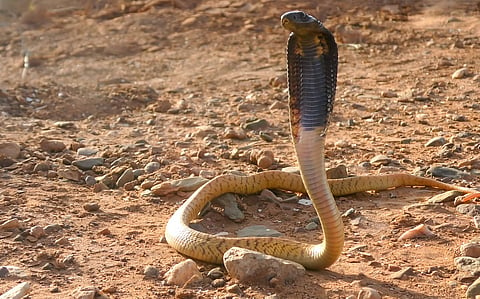

An international team of researchers led by Andreas Hougaard Laustsen-Kiel from DTU Bioengineering in Copenhagen, Denmark, has discovered what it claims is a game changer for snakebite, a neglected tropical disease (NTD) that kills millions across the tropics every year.
The new anti-venom is not made by extracting antibodies from the blood of large mammals like horses. Instead, it uses latest technology to extract antibody fragments or ‘nanobodies’ which are then used for making the anti-venom.
There are several advantages of the new method to make anti-venom over the old one.
The anti-venom made the old way produces a large, undefined mixture of antibodies, only a small proportion of which target and neutralise the most dangerous toxins. This method produces a product with great variation in quality and a risk of serious side effects.
Secondly, there is also no single anti-venom that covers all relevant snake species. As a statement by DTU Bioengineering noted, this creates a lot of problems.
“This can be particularly problematic if a person is bitten somewhere in Central Africa, where several venomous species live side by side. For example, the venom of the cape cobra and the spitting cobra contain very different toxins: the cape cobra’s venom consists primarily of neurotoxins that paralyze the nervous system, while the spitting cobra’s venom is rich in cytotoxins, which, among other things, break down tissue and can lead to amputation. This great variation means that an anti-venom that works against one species does not necessarily work against another – and therefore it is crucial to develop an anti-venom that covers several species.
Developing an anti-venom that can provide correct and optimal treatment is of utmost importance.
Snakebite envenoming is among the world’s deadliest yet most overlooked tropical disease. The World Health Organization has classified snakebite envenoming as one of 21 NTDs, resulting in between 100,000 and 150,000 deaths worldwide each year. Three times as many survive with serious disabilities, including amputations and permanent tissue damage.
In sub-Saharan Africa, more than 300,000 snakebite cases are recorded annually. More than 7,000 people lose their lives, while around 10,000 undergo amputations. The actual extent—also globally—is probably much greater, as many cases go unreported.
The international team of researchers has developed a more effective and broadly effective anti-venom by combining eight carefully selected nanobodies into a cocktail that targets venom from 18 medically relevant African snake species.
“During in vivo testing, the anti-venom has shown promising results and covered a wide spectrum of snake species, increasing its potential for effective treatment in real-life cases. In experiments where the anti-venom was mixed directly with the venom before being injected, it successfully neutralized venom from 17 out of 18 tested different snake species, with the exception of one of the green mambas.”
The 17 species are:
Jameson’s mamba (Dendroaspis jamesoni)
Black mamba (Dendroaspis polylepis)
Western green mamba (Dendroaspis viridis)
Rinkhals (Hemachatus haemachatus)
Cape cobra (Naja anchietae)
Cape cobra (Naja annulifera)
Spitting cobra (Naja ashei)
Egyptian cobra (Naja haje)
Spitting cobra (Naja katiensis)
Forest cobra (Naja melanoleuca)
Spitting cobra (Naja mossambica)
Spitting cobra (Naja nigricincta)
Spitting cobra (Naja nigricollis)
Cape cobra (Naja nivea)
Spitting cobra (Naja nubiae)
Spitting cobra (Naja pallida)
Cape cobra (Naja senegalensis)
According to the researchers, the new anti-venom offers other benefits as well. Nanobodies penetrate tissue faster and deeper than the larger antibodies in current anti-venoms.
“Even with delayed treatment, nanobodies appear to effectively reduce tissue damage, whereas current anti-venoms have only a limited effect. At the same time, nanobodies carry a much lower risk of serious immune reactions compared to today’s anti-venoms. This means treatment could be started earlier, without waiting for clear symptoms – unlike current practice, where clinicians often delay administration to avoid triggering dangerous side effects,” according to the statement.
Clinical trials could begin in one to two years with the right support while a finished product could potentially be ready within three to four years, the researchers estimate.
Nanobody-based recombinant antivenom for cobra, mamba and rinkhals bites was published in Nature.